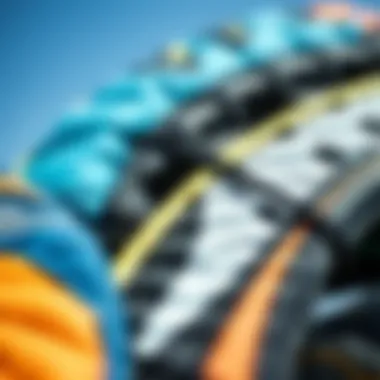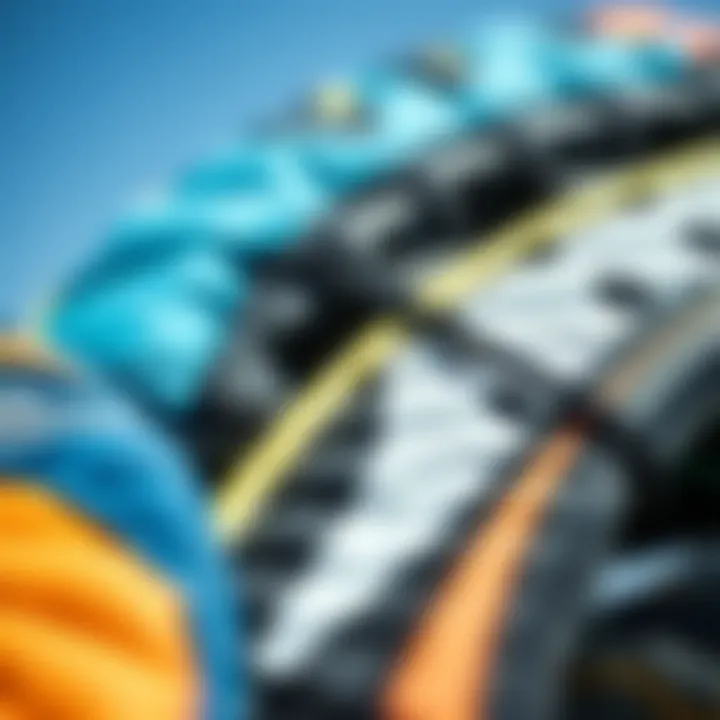Exploring the Market for Kite Wings: A Comprehensive Guide


Intro
Kites have come a long way from being mere toys for children; now, they have evolved into sophisticated pieces of technology that thrill adventurers and athletes alike. In the kiteboarding sphere, the role of the kite wing cannot be overstated. This article seeks to shed light on the diverse marketplace for kite wings, breaking down essential features, types, and the dynamics that govern their market.
It’s an exciting time for the kiteboarding community, with a growing selection of kite wings available. Whether you’re just dipping your toes into the world of kiteboarding or you're a seasoned pro looking to upgrade, this guide will equip you with the know-how you need to make informed choices. Understanding kite wings is not just about picking one that looks flashy; it's about knowing what goes behind the design and materials used, as well as the seasonal trends that can sway your buying decisions.
From materials and sizes to the reputation of manufacturers, we’ll explore the intricate components that make kite wings unique. As you delve deeper, you will learn how to navigate pricing and understand seasonal demand variations. Finally, tailored insights will guide both beginners and expert kiteboarders in making the best selections suited to their distinct needs.
Let's start our journey into this fascinating world by examining the vital gear and equipment that makes kiteboarding not just a sport, but a thrilling lifestyle.
Understanding Kite Wings
Kite wings are more than just colorful fabric soaring above the waves; they're a fundamental component of the kiteboarding experience. As the sport continues to grow, understanding kite wings has become increasingly important for both novice and veteran riders. This section sheds light on the components and definitions essential to kite wings, which ultimately influences decision-making during purchases. Familiarity with these details empowers enthusiasts to navigate the market effectively, elevate their performance, and even enhance safety on the water.
Definition of Kite Wings
Kite wings, often referred to simply as kites, are the inflatable structures that catch the wind and propel riders forward on a board, allowing them to harness the power of nature. These wings can take various forms, but fundamentally, each kite shares the goal of transforming wind energy into motive force. They create lift and drive through their design, making them a crucial element of kiteboarding systems.
Components of a Kite Wing
Every kite wing has several critical components, each playing a unique role in its performance and functionality:
Leading Edge
The leading edge is like the bow of a ship slicing through the water. It’s the front part of the kite and dictates how effectively the wing can catch air. A well-designed leading edge enhances aerodynamics, which is crucial for speed and control. Manufacturers often build it with stiff materials to ensure it maintains shape under pressure. The smooth design reduces drag, making for a much more efficient ride. However, if it's too rigid, it may limit flexibility, potentially affecting performance in dynamic conditions. Thus, selecting the right leading edge is fundamental for a kite's responsiveness during difficult maneuvers.
Canopy
The canopy is the expansive surface area that balloons when filled with wind. It's generally made from lightweight, high-tenacity fabrics, which helps in maintaining durability while ensuring minimal weight. An important aspect of the canopy is its shape—this can determine how the kite behaves in gusty winds. Specific designs can enhance lift while others may prioritize downwind speed. Nonetheless, a canopy that’s too delicate can risk ripping, while one that's excessively stiff might hinder performance. Striking a balance is key here; it plays an instrumental role in how the kite handles across varying conditions.
Struts
Struts are the ribs that give the kite its form and structure. These internal components hold the canopy taut, allowing air to fill the kite evenly while maintaining its shape during flight. A solid strut design contributes significantly to stability, particularly in higher winds. However, adding too many struts can increase the weight, negatively impacting agility and responsiveness. Struts are often crafted from robust materials, but ensuring they don’t weigh the kite down excessively is pivotal for optimal function.
Bridle Lines
Bridle lines are the unsung heroes of kite wings. They connect the kite to the line and influence how it flies by adjusting the angle of attack against the wind. Bridle systems come in various configurations, and their effectiveness can largely determine the performance and stability of the kite. A well-thought-out bridle line setup can make the difference between a kite that reacts beautifully and one that struggles in turbulent air. However, having too many lines creates complexity that can lead to tangles and difficulties during setup or flight. Choosing the right bridle line design tailored to your style could elevate your kiteboarding experience significantly.
Types of Kite Wings
Understanding the different types of kite wings is essential for anyone looking to make an informed choice in the market. Each type comes with unique characteristics that cater to specific riding styles, wind conditions, and personal preferences. Choosing the right type can significantly enhance your kiteboarding experience. In this section, we will explore the distinctions between various kite wing types, providing insight into the benefits and considerations for each.
Foil Kites Versus Inflatable Kites
When it comes to kite wings, one of the fundamental distinctions lies between foil kites and inflatable kites.
Foil Kites: As the name suggests, foil kites do not have any rigid structure; they rely on air pressure to maintain their shape. Made typically of lightweight fabric with internal cells that inflate, these kites are known for their efficiency and ability to fly in a wide range of conditions. They are particularly favored in light wind situations due to their responsiveness and reduced drag. Riders often find that foil kites offer great stability and control, making them an attractive option for skilled kiteboarders.
- Pros:
- Cons:
- Better performance in light winds
- Compact and easy to pack
- Improved stability
- Can be challenging for beginners
- Requires good technique to operate effectively
On the other hand, Inflatable Kites are made with bladders that create a structure for the kite, filled with air for buoyancy. They are often preferred by novices for their forgiving nature and easy relaunch capabilities. Inflatable kites perform well in stronger winds, providing lift and power that can be harnessed for tricks and jumps.
- Pros:
- Cons:
- Easy to handle for beginners
- Excellent relaunching from the water
- Good power in stronger winds
- Heavier to transport
- Less efficient in light wind "compared to foil kites"


Freeride Kite Wings
Freeride kite wings are designed for flexibility and versatility. They strike a balance between performance and ease of use, making them popular amongst kiteboarders who enjoy cruising and exploring different styles. Freeriders often appreciate having a kite that can comfortably adapt to various conditions without becoming unwieldy. This type typically features moderate aspect ratios, which help with stability and control while allowing for easy transitions between different maneuvers.
A freestyle kite wing, for example, may have a slightly wider construction to facilitate flips and spins, while still being able to handle gusts effectively. The best freeride wings instill confidence in riders, allowing them to push their limits without fear, making them suitable for kiteboarders from all backgrounds.
Race and Performance Kite Wings
For those with an adrenaline itch and the desire for speed, race and performance kite wings are the go-to choice. Designed to slice through the air with precision, these kite wings boast a higher aspect ratio, allowing for greater efficiency and speed in competitive settings. If you're looking to become the fastest on the water, this type of wing yields high-performance capabilities that cater to serious racers.
Some characteristics of race and performance kite wings include:
- Lightweight materials for rapid acceleration
- Streamlined design to reduce drag
- Enhanced control surfaces that allow precise turning and agility
However, they often come with a steeper learning curve; inexperienced riders might find them too aggressive or challenging to master. Nonetheless, for those willing to put in the effort, the speed and thrilling sensations these kites offer provide a rewarding experience unmatched by any other type.
By thoroughly understanding these different types of kite wings, kiteboarders can better navigate their choices, ensuring that their equipment aligns precisely with their riding style and aspirations.
Key Features to Consider
Selecting the right kite wing goes beyond mere aesthetics or brand popularity; it’s a careful orchestration of features that enhance performance and user experience. Understanding these key elements will help those in the market, whether they are seasoned kiteboarders or entrants to the thrilling world of kiting. Focusing on factors like material quality, size, aspect ratio, and design innovations can make a world of difference in your kiteboarding adventures.
Material Quality
Material quality is right at the heart of any kite wing’s performance. The materials used impact everything from strength and durability to responsiveness in various wind conditions. High-grade materials tend to stand up against rigorous use and offer better performance overall.
Durability
Durability is the linchpin in kite wing design. It’s not just about using strong materials; it's also about how they respond under pressure. A durable kite wing can withstand hard pulls and harsh landings, which is crucial for kiteboarders who push the envelope. Many kite enthusiasts gravitate toward wings made with ripstop nylon or polyester as they provide resistance against tearing.
Key characteristic of durability: Effective resistance to wear and tear.
Why it's beneficial: Durable kite wings resist damage, reducing the frequency of replacements and ensuring a steady ride in robust winds.
On the downside, durability often means heavier materials. While a robust wing can handle strong winds, it might not perform as well in lighter conditions. So, balancing durability with the kite's overall weight becomes critical for performance.
Weight
Weight plays a crucial role in the overall dynamics of a kite wing. A lightweight kite wing can catch the wind more easily, making it highly responsive and enjoyable to ride. This results in a more exhilarating experience, particularly for those who love freestyle trick riding or navigating tricky terrains.
Key characteristic of weight: Lightweight design leads to better maneuverability.
Why it's popular: Many kiteboarders prefer lighter wings for their ability to perform tricks and catch air more efficiently.
However, opting for ultra-light materials can compromise durability, especially in high-stress scenarios. So, kiteboarders are often faced with the choice of sacrificing longevity for performance and ease of use. Finding that perfect balance is essential when considering how much weight matters.
Size and Aspect Ratio
The size and aspect ratio of a kite wing are integral to its flight characteristics and responsiveness. A larger wing often means greater lift, which is beneficial for heavy winds, while a smaller size could allow for greater control in lighter conditions. The aspect ratio describes the relationship between the wingspan and the surface area of the kite. A higher aspect ratio typically enhances the wing's performance but may sacrifice stability for a more finesse-based flight.
Design Innovations
In an ever-evolving market, new designs emerge that cater to specific needs and advancements in technology. Innovations in kite wing design impact aspects like aerodynamics, stability, and ease of use. Features such as adjustable bridle connections, or modular systems that allow for easy repairs or upgrades, are increasingly gaining traction. Additionally, hybrid designs might make their way to avid kiteboarders, providing the best of both foil and inflatable kites, offering performance tailored to various skill levels.
Navigating these key features and understanding their nuances puts kiteboarders in a better position to make wise decisions when purchasing kite wings. The fabric of kite wing design intertwines various elements, each bringing unique advantages and challenges, ultimately tailor-fitting the kiteboarding experience.
Where to Buy Kite Wings
Finding the right kite wing is crucial for anyone serious about kiteboarding. The choice you make can greatly influence your overall riding experience, and knowing where to purchase a kite wing can save you time and possibly some cash. Some buyers may gravitate toward online platforms, while others prefer walking into local shops where they can physically see the product. Each buying avenue has its own merits and pitfalls, making it essential to weigh your options thoroughly before committing.
Online Retailers
In today’s digital age, online retailers have become a popular destination for purchasing kite wings. Not only do they often provide a larger selection than you might find in brick-and-mortar stores, but they also allow you to compare prices at the click of a button. This accessibility can be a double-edged sword; you'll want to be mindful of the following:
- Price Comparison: Most e-commerce sites, like Amazon or specialized kiteboarding stores, allow you to monitor prices easily across different brands and styles, ensuring you get the best deal that fits your budget.
- Product Reviews: Customer reviews and ratings are readily available, giving you insight into the performance, durability, and reliability of a specific kite wing before you make the leap.
- Convenience: Shopping from the comfort of your own home means you can take your time to read product descriptions and decide what suits you best without anyone rushing you.
However, it’s crucial to watch for shipping costs and return policies. A great price upfront may be offset by expensive delivery charges or a poor return policy if the kite wing doesn’t meet your expectations. Remember, just because something looks good on a screen doesn’t mean it’ll perform well in the sky.


Local Shops and Distributors
Brick-and-mortar stores, particularly those specializing in outdoor sports, can provide an invaluable experience when shopping for kite wings. Here’s why:
- Hands-On Experience: One of the significant advantages of local shops is the ability to physically inspect the kite wings. You can feel the materials, check the stitching, and even potentially seek advice from knowledgeable staff who share your passion for kiteboarding.
- Instant Gratification: Instead of waiting for shipping, you can take your kite wing home the same day and hit the beach right away.
- Community Connection: Local shops often foster a sense of community, and sometimes they host events or offer classes where you can learn more about using your new gear effectively. This connection can add value beyond the purchase itself.
However, smaller shops may have limited inventory. If you’re looking for the latest models or specific designs, you might need to plan ahead or call ahead to ensure they have what you need in stock.
Second-hand Marketplaces
If you're on a budget or looking to try out kiteboarding without a massive upfront investment, checking second-hand marketplaces presents a solid option. This can include:
- Platforms like eBay or Craigslist: Here, you can often find lightly used kite wings at a fraction of the new retail prices. Just be sure to examine the seller’s reputation and ask for detailed photos or descriptions.
- Local Community Boards or Facebook Groups: Many areas have specific groups dedicated to water sports where members sell or trade gear. Engaging with local kiteboarding communities can lead to excellent bargains.
While there's potential for great savings, buying second-hand comes with risks. Inspecting the kite wing for wear, damages, or missing components before handing over cash is critical. Transparency is key, so do not hesitate to ask questions.
"In every purchase, research and comparison are your best allies in making an informed choice that aligns with your needs."
Whether going the digital route, hitting up a local shop, or hunting for a bargain in the second-hand market, understanding where to buy kite wings can dramatically affect your experience and satisfaction. Do your homework, and you’ll be well on your way to finding the perfect kite wing for your next adventure.
Pricing Factors
When considering the purchase of a kite wing, the pricing factors are crucial. They serve not only as a guide to affordability but also as a reflection of quality, brand reputation, and current market trends. Understanding these factors enables consumers to make informed choices, ensuring they maximize the value of their investment.
Material and Construction Costs
The material and construction costs can significantly impact the final price of a kite wing. High-quality materials, such as ripstop nylon or polyethylene, provide durability and resistance against the elements, which can prolong the lifespan of the kite. On the other hand, cheaper materials might tempt the wallet, but in the long run, they are likely to lead to disappointment when you find yourself replacing your kite wing after just a few uses.
Each component, from the canopy to the struts, plays a role in the overall cost. For instance, wings with advanced features like reinforced seams or aerodynamic profiles often carry a higher price tag. Yet, these enhancements directly contribute to performance and safety.
"Investing in a quality kite wing upfront can save you headaches and money down the road."
Brand Significance
Brand significance is another factor that often dictates pricing. Well-established brands like Duotone or North Kiteboarding often command higher prices not just because of their reputation but due to their commitment to quality and performance. These brands invest heavily in research and development. As a result, they provide products that frequently meet or exceed expectations in terms of durability and design. Conversely, lesser-known brands or newcomers to the market may offer lower prices, hoping to attract budget-conscious customers, but they may lack the same level of reliability and customer service.
Understanding the brand’s standing in the community can greatly influence a buyer’s decision. Reviews and feedback from fellow kiteboarders can be invaluable in assessing whether a brand is worth the price asked.
Market Trends and Seasonal Prices
Market trends and seasonal prices also play an important role in kite wing pricing. Typically, the kiteboarding season influences demand, leading to price fluctuations throughout the year. In peak seasons, prices often rise due to the increased demand for kite wings. On the flip side, off-season might yield discounts and clearance sales, making it an excellent time for budget-conscious buyers to grab a deal.
In addition, trends in kite wing technology can affect pricing. If a new technology or design becomes popular, it might drive up the price of related products. Seasonal sales and industry innovations create a dynamic marketplace. Thus, keeping an eye on market trends can lead to advantageous purchasing decisions.
By comprehensively analyzing these pricing factors, buyers can navigate the complexities of the kite wing market effectively, ensuring they get the right wing for their needs at a fair price.
Evaluating Brands and Manufacturers
When it comes to kite wings, the brand and manufacturer you choose can greatly impact your experience. This section highlights why it's critical to evaluate these aspects before purchasing. A reliable brand often indicates quality, longevity, and performance. You'll want to focus on a brand's reputation, what feedback other users have shared, and the level of support they offer after a sale. These components provide a clearer picture of the value you are getting.
Reputation in the Industry
A kite wing’s reputation in the industry is a key indicator of its performance and reliability. Well-respected brands often have years of expertise, innovations in design, and a commitment to quality laser-engraved in their lifeboat. These companies are usually more transparent about production techniques and materials—traits that can significantly reduce the risks involved in your purchase. When researching, consider how long the brand has been active, what types of kite wings they specialize in, and any awards or accolades they’ve received from the kiteboarding community.
- Longevity: Companies with a strong track record are usually a safer bet.
- Innovations: Brands known for pushing the envelope in kite technology tend to deliver superior products.
- Industry Endorsements: Look for endorsements from professional kiteboarders; they often have experience with multiple products and can offer valuable insights.
Customer Feedback and Reviews
Customer feedback is like gold dust in today’s consumer-driven market. Pay attention to reviews and discussions across various platforms, ranging from social media to dedicated forums on websites like Reddit and Facebook groups. Take the time to read both positive and negative reviews; for instance, a brand may receive praise for its high-speed performance but face complaints about durability.
- Common issues: List any recurring problems or praises in reviews to understand potential pitfalls or strengths.
- Ratings on e-commerce sites: Check out platforms like Amazon or specialized kite shops; ratings here can give you quick insight into general satisfaction.
- Community insights: Engage with fellow kiteboarders to gather personal experiences; often, these firsthand accounts will provide perspectives you won’t find in official reviews.


Warranty and Support Services
Warranty and support are essential considerations that can safeguard your investment. Many reputable brands offer warranties that cover defects in workmanship and materials. However, a warranty is only as good as the support that comes with it. The process for claims should be straightforward, and companies should be responsive to customer inquiries after the sale.
- Warranty length: A longer warranty period often reflects a manufacturer's confidence in their product.
- Support channels: Check if they provide multiple support avenues like live chat, email, or phone consultations. This can ensure that if you run into trouble, you have options.
- User manuals and guides: Good manufacturers often provide thorough documentation for their products, which can help you understand your kite wing better and use it effectively.
In summary: Evaluating brands and manufacturers is vital for making an informed decision regarding kite wings. Reputation, customer feedback, and warranty policies are primary factors that can guide you toward a quality purchase.
The Importance of Testing
Testing kite wings is not merely a suggestion; it’s an essential part of the purchasing process that can significantly influence your experience on the water and in the air. It’s akin to trying on a pair of shoes before buying them—doing so ensures a proper fit. Understandably, when you’re dealing with something as dynamic as kite wings, proper testing becomes paramount to achieving optimal performance.
The core benefits of testing can be broken down into a variety of aspects that kiteboarders, both novice and expert, should consider:
- Informed Decision Making: Testing provides firsthand experience which equips users with the knowledge needed to choose the right kite wing tailored to their style.
- Understanding Adaptability: Kite wings operate differently in varying conditions. Through testing, you’ll understand how your choice performs in different wind strengths and types of water.
- Customization: By tweaking design elements during test flights, you can find the perfect adjustments to your setup for personal comfort and control.
"Testing kite wings before your buy is like putting your heart and soul into crafting a recipe—each ingredient matters, and how they blend defines the outcome."
Test Flights and Adjustments
When embarking on the journey of test flights, it's crucial to approach the task with a clear plan in mind. Start by selecting a set of conditions that represent varied wind and water scenarios.
- Wind Conditions: Find areas where the wind typically fluctuates. Understand how your kite wing behaves in both moderate and gusty winds. Each test should highlight unique aspects of performance, from lift to stability.
- Initial Settings: Set the kite wing according to manufacturer recommendations. This is often a safe starting point, but adjustments should be made based on flight feedback.
- Recording Data: It’s beneficial to keep a log of each test session, noting the changes made and their impacts on performance. Over time, this will provide a valuable reference for future use.
Evaluating Performance Under Different Conditions
Once the test flight is complete, it’s time to delve deeper into the kite wing’s performance across different conditions:
- Light Winds: Observe how the wing reacts when the breeze is soft. Does it maintain lift, or does it struggle? For many kiteboarders, understanding this characteristic separates a good kite from a great one.
- Heavy Gusts: Take it for a spin on a gusty day to see if it remains controllable or if it’s prone to overstabilizing. This evaluation is critical for determining the kite’s reliability during unpredictable weather.
- Water Surface Types: Testing in different water conditions, from calm lakes to choppy oceans, will expose how the kite interacts with various elements. The way it rides on a flat surface contrastingly shows its capability on rough waters.
By integrating extensive testing and evaluating performance under various conditions, kiteboarders can enhance their selection process. A kite wing that performs reliably in all circumstances will ultimately lead to a more enjoyable and safe kiteboarding experience. This thorough understanding not only boosts confidence but also contributes to skill advancement in the sport.
Closure
As we wrap up our exploration of the kite wing market, it's vital to understand the broader implications of this knowledge. Kite wings are not just pieces of gear; they embody the spirit of adventure and freedom that comes with kiteboarding. By comprehensively analyzing the factors involved in purchasing kite wings, we've gathered critical insights that can guide both novices and veterans in their decisions.
Recap of Key Takeaways
Reflecting on the key points discussed throughout this article, here’s a quick rundown:
- Understanding Kite Wings: Knowing what constitutes a kite wing, including components like the leading edge, canopy, and struts, is fundamental for making informed choices.
- Types Offer Variety: Distinguishing between foil kites and inflatables, as well as understanding freeride versus racing designs, is essential to matching your needs to the right product.
- Key Features Matter: Elements like material quality, size, and innovative designs play a significant role in performance. This affects everything from durability to how kite wings handle under various conditions.
- Buying Considerations: The landscape of sellers—from online retailers to local shops—affects accessibility and pricing. Always consider where and who you are buying your equipement from.
- Pricing Factors: Understanding how material costs, brand reputation, and seasonal trends impact pricing will better prepare you for negotiations or budget planning.
- Brand Evaluation: Knowing what brands to trust can save you from subpar products. Customer feedback and warranties are telling signs of a brand’s reliability.
- Importance of Testing: Before making a purchase, testing is crucial. Be it through a demo flight or checking reviews from fellow kiteboarders, ensuring that the kite wing meets your performance expectations is critical.
The kite wing you choose can significantly enhance or hinder your skill development and experience on the water. Armed with the insights from this article, you can make choices that resonate with your specific kiteboarding aspirations. Whether it's harnessing the power of the wind during a casual ride or racing against fellow enthusiasts, your kite wing could be the difference between a good day and an extraordinary one.
For further insights and discussions around kiteboarding, explore resources like Wikipedia, Britannica, or join the conversations on Reddit.
Dive into your next kiteboarding adventure with confidence, knowing that you have made an informed decision.
Further Resources
In the ever-evolving domain of kiteboarding, having access to credible resources is essential for both newbies and seasoned riders. This section provides a practical guide on where to find valuable information that can enhance the kiteboarding experience significantly.
Kiteboarding Tutorials
Kiteboarding tutorials serve as a crucial pillar in the kiteboarding community. They offer structured learning paths for those looking to master the sport, regardless of their starting point. Instructional videos or written guides, often found on websites like YouTube or specific kiteboarding platforms, cover a variety of skills from basic setup to advanced maneuvers.
- Step-by-Step Instructions: Tutorials break down complex techniques into manageable steps. This can help riders feel more confident as they progress.
- Visual Aids: The importance of visual learning cannot be overstated. Seeing a maneuver demonstrated can clarify doubts and teach the subtleties of movement.
- Skill Levels: From beginner to expert, tutorials cater to all skill levels. Newcomers can find resources geared towards their specific needs, while veterans can seek to refine their skills.
- Safety Guidelines: Many tutorials emphasize safety practices, ensuring new riders understand crucial safety information right from the start.
For an extensive collection, visit Kiteboarding.com for various tutorials designed to ease the learning curve and improve performance on the water.
Community Forums and Discussions
Engaging with community forums provides kiteboarders a unique opportunity to connect, share experiences, and learn from one another. These platforms offer a wealth of knowledge as well as support from fellow enthusiasts.
- Real-time Feedback: Engaging in forum discussions allows individuals to ask questions and receive immediate responses from experienced kiteboarders or instructors.
- Resource Sharing: Members often share resources such as gear recommendations, local wind conditions, or safety tips tailored to specific locations.
- Networking: Forums foster relationships and networking opportunities within the kiteboarding community, which can lead to ride partners or mentorship opportunities.
- Event Announcements: Community-based forums often share updates on local events, competitions, or gatherings where riders can meet and share their passion.
A prime destination for community engagement is Reddit, where users frequent discussions on various topics related to kiteboarding and can seek advice from others who share similar interests.
Building connections in the kiteboarding community not only enriches your skills but also enhances your overall experience, whether you are hitting the waves solo or alongside fellow enthusiasts.















